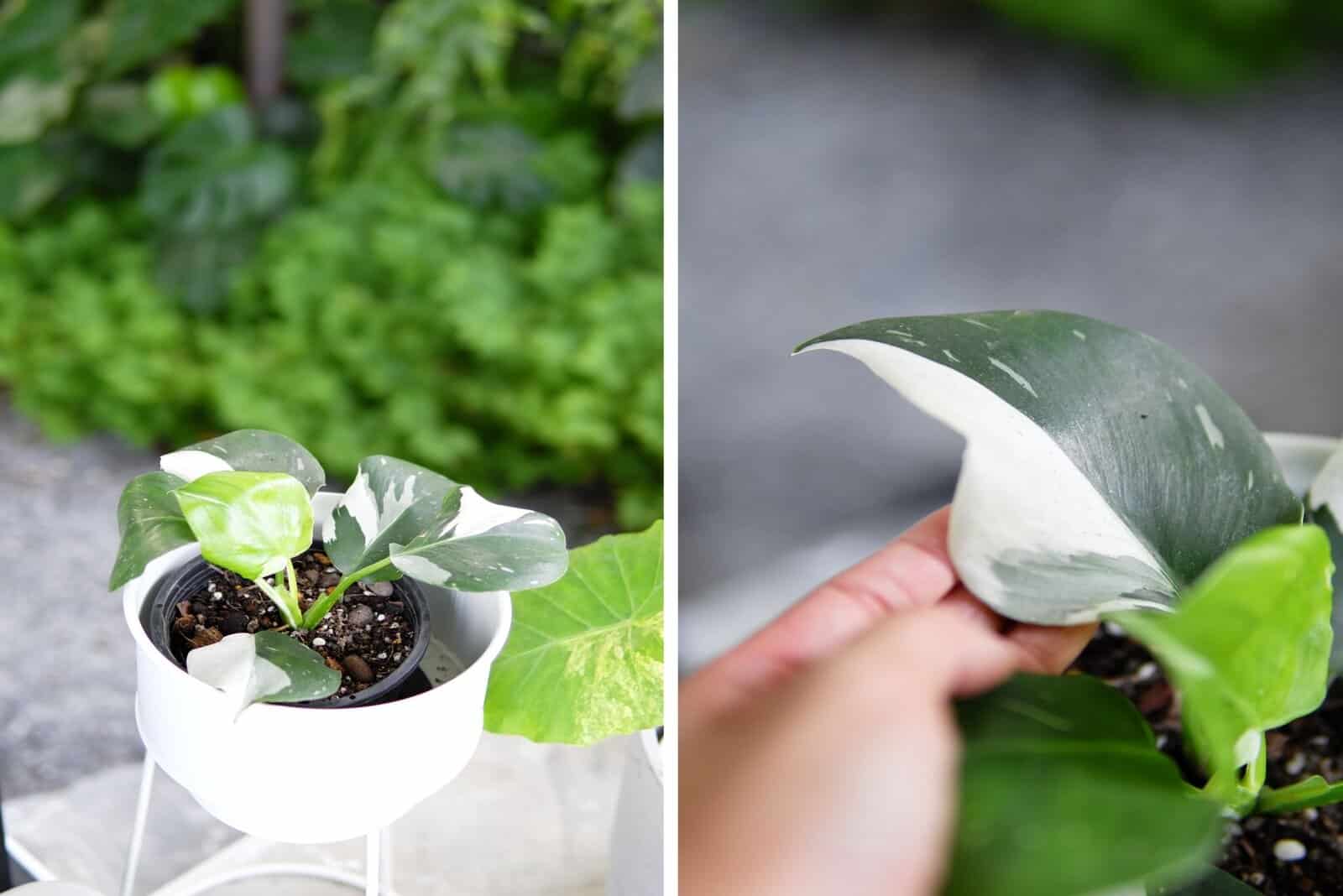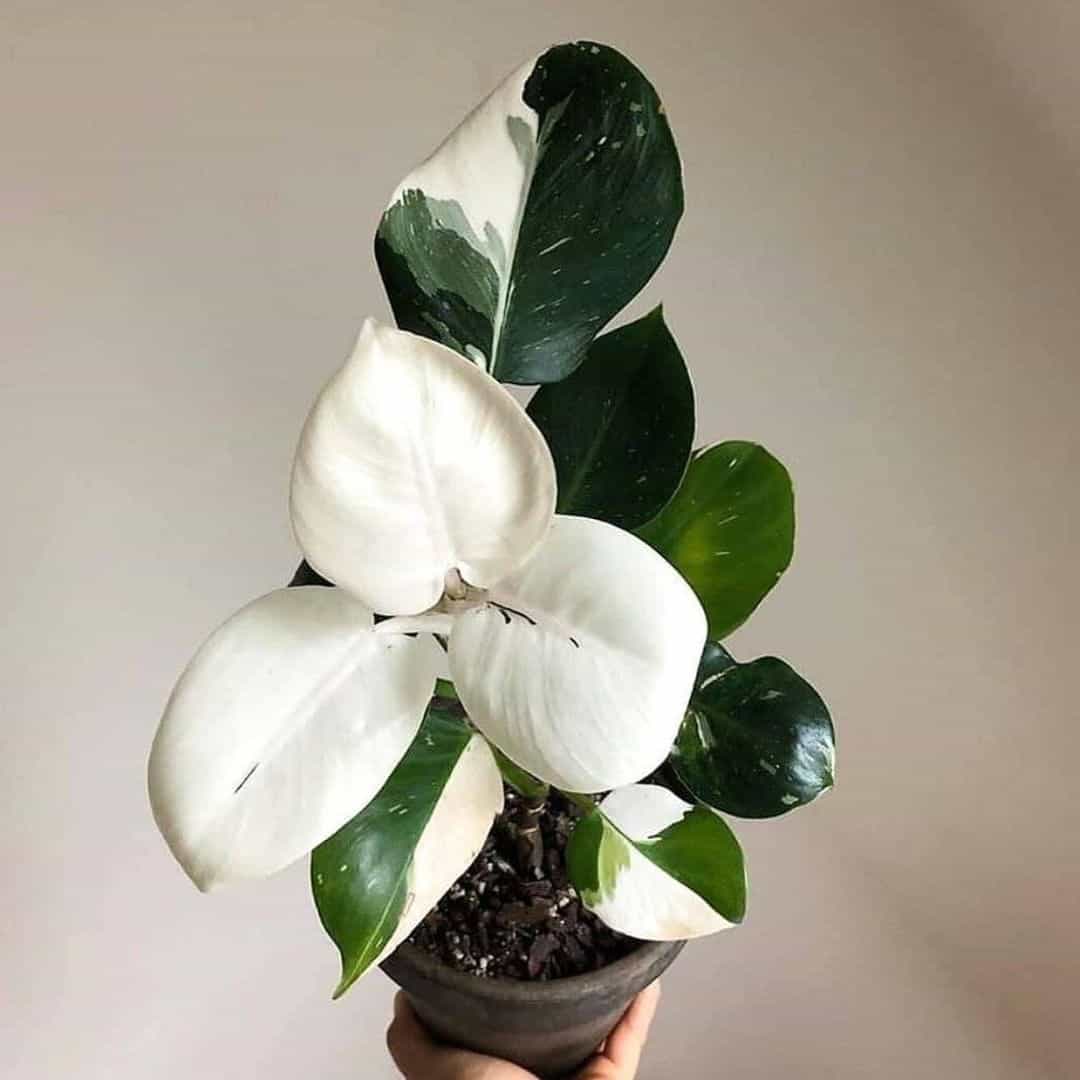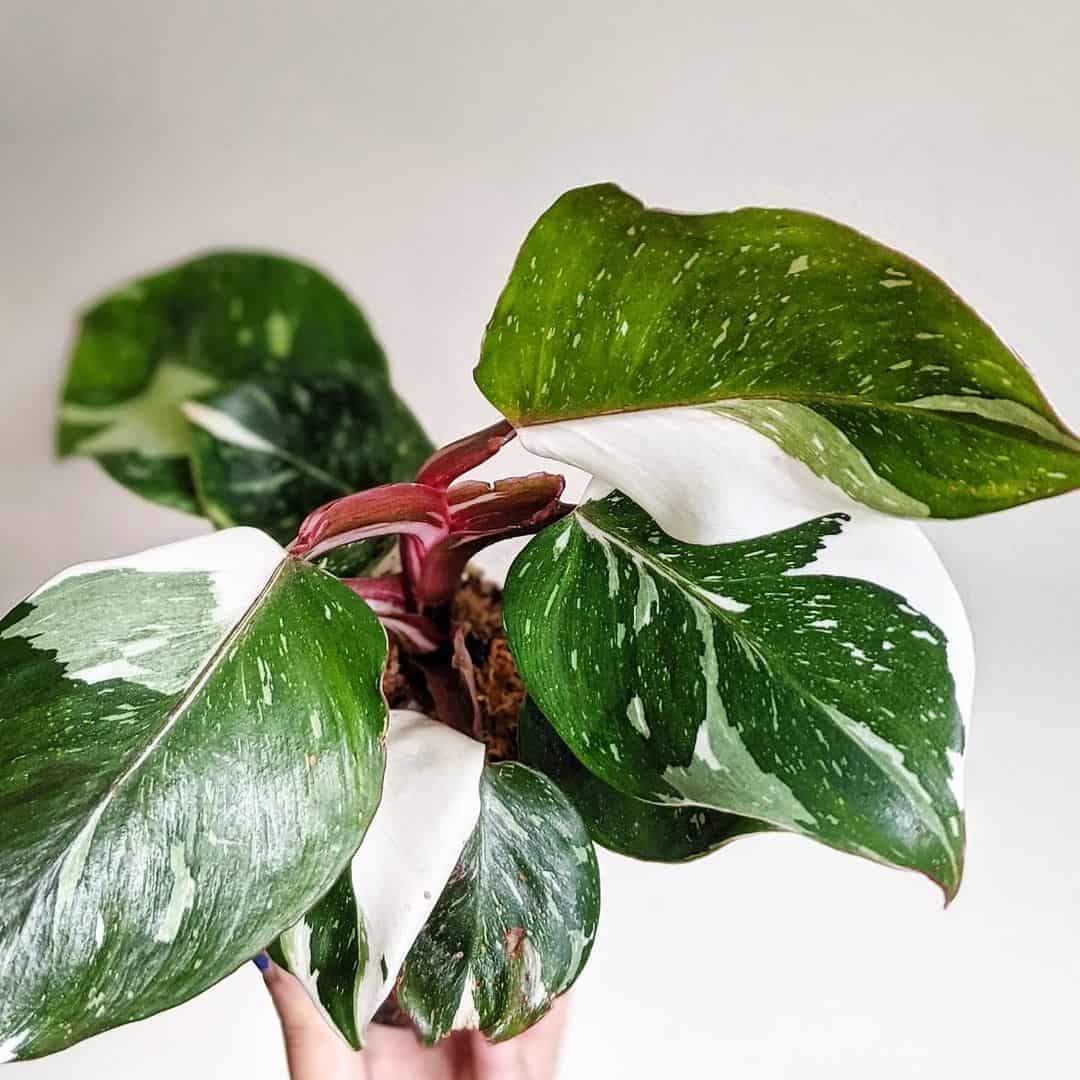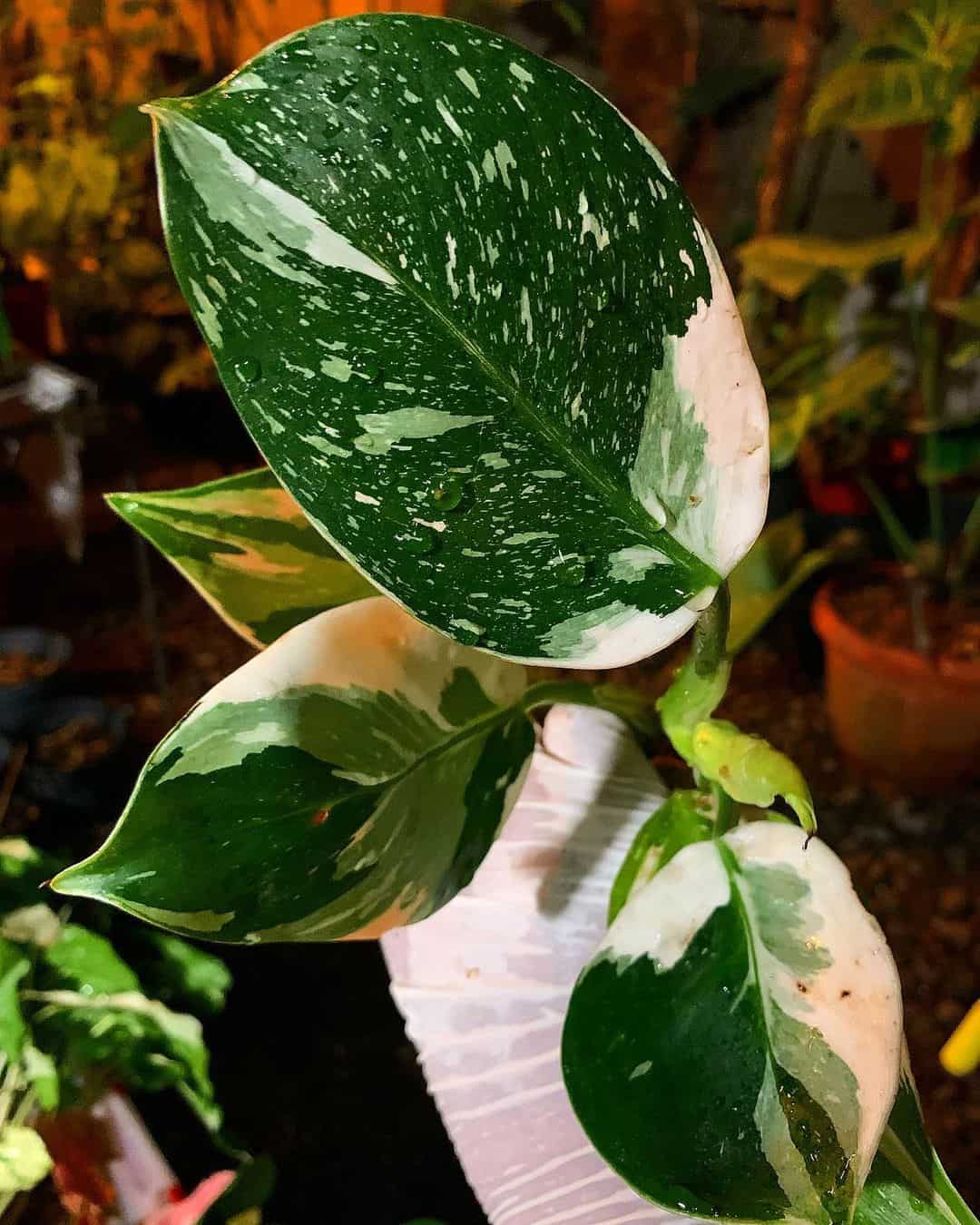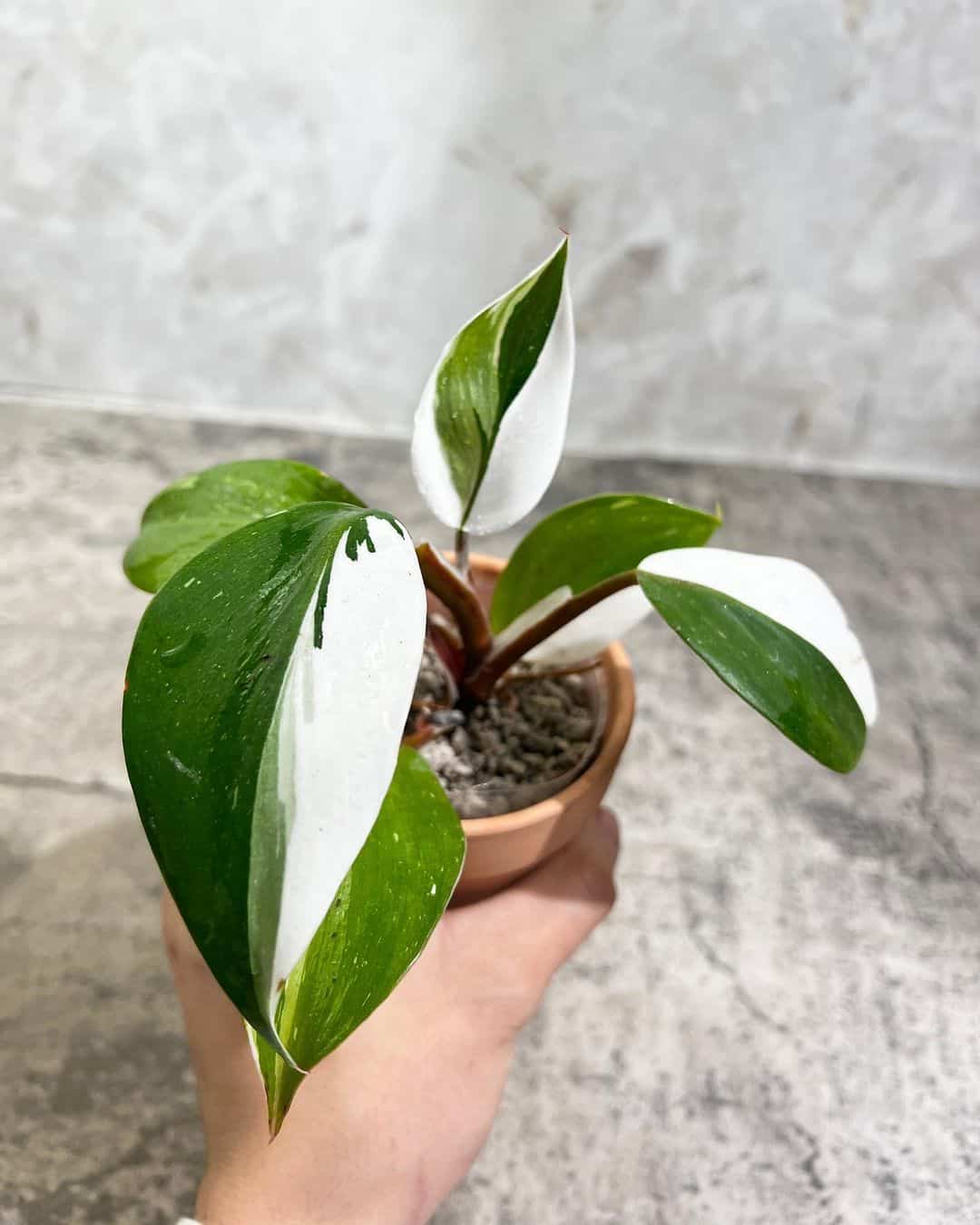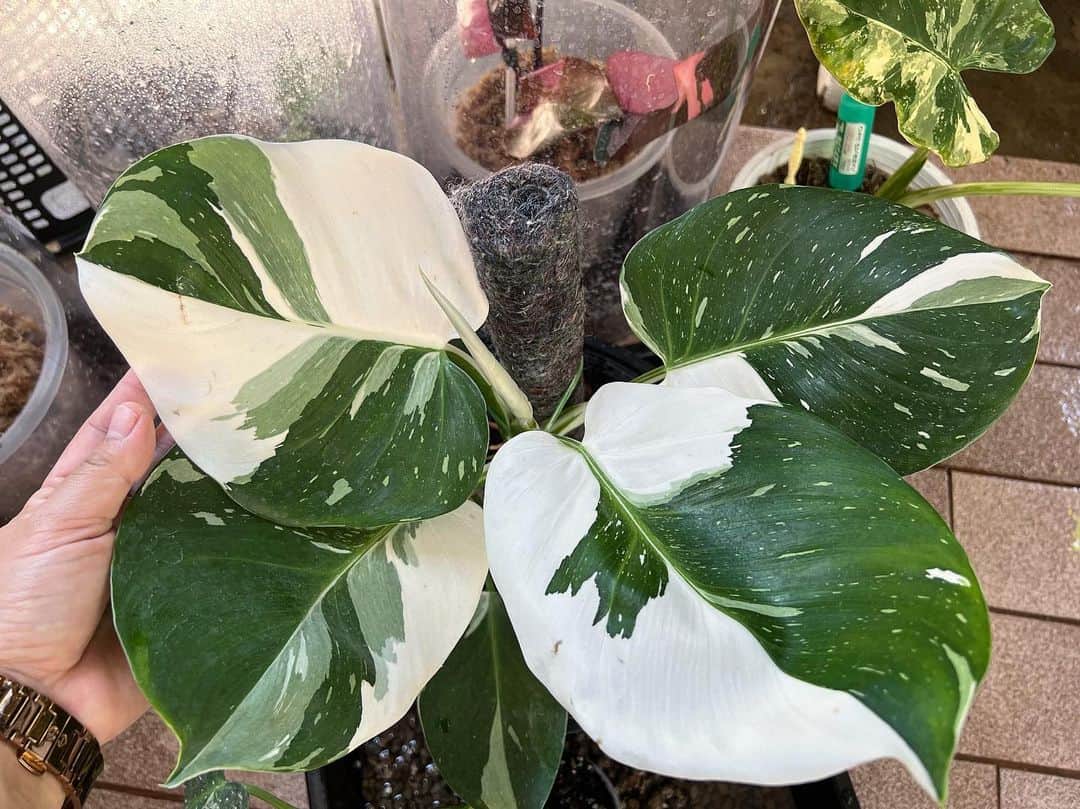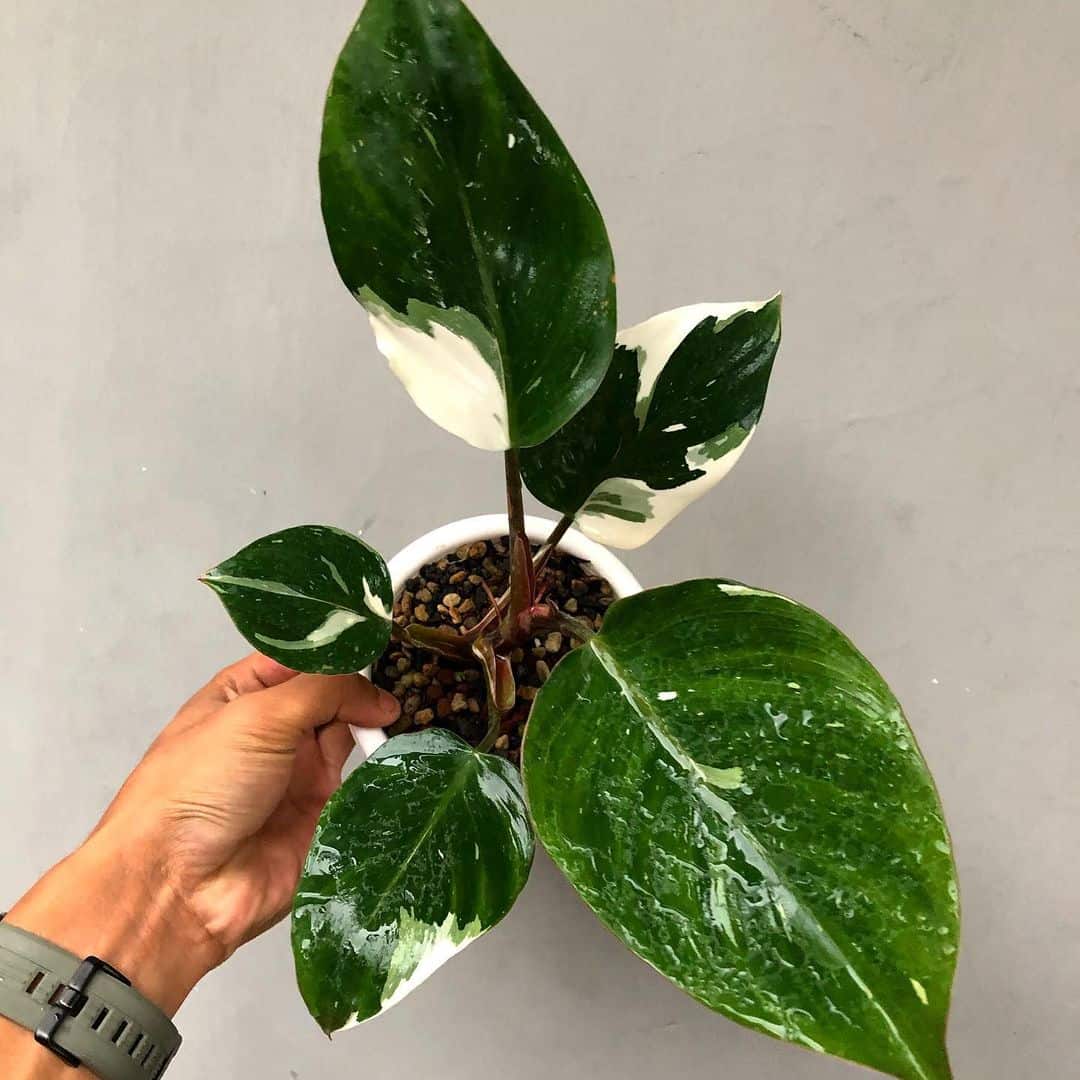These varieties of philodendron are collectors’ favorites. Philodendron White Wizard vs White Knight are more similar than different, but there are some specific characteristics that you can use to differentiate them.
But first, let’s look at some general specifics:
[table id=40 /]
Now that you have the basic information about these two aroids, it’s time to inspect them more closely.
Philodendron White Wizard vs White Knight
Photo from:@jungle_collective
There are three main differences in the Philodendron White Wizard vs White Knight conversation: the size of their foliage, the color of their leaves and stems, and their growth rate and size.
In this section, we will carefully examine each of these differences, so you will have no difficulties differentiating these two varieties from now on, and choosing which one is going to make company to your Imperial Green philodendron .
1. Foliage
The amazing variegations of both Philodendron White Wizard vs White Knight are the first thing that draws you to these plants.
Sometimes, it’s difficult to distinguish between these variegated plants based on their foliage color alone. That’s why the main things to pay attention to when buying one of these plants are the shape and size of their leaves.
Of course, you won’t be disappointed with either of these fantastic houseplants, but it’s always good to know which one you’re getting.
On that point, the White Wizard has more prominent and rounded leaves than the White Knight. It’s a matter of preference, so you can always buy both!
2. Color
Now we come to the most exciting thing about these variegated philodendrons: their color.
There are differences in variegations of the leaves and the color of their stems. However, they have color in common, and they’re both always white.
Petioles
The White Wizard has your everyday green stem, but it is often streaked, or rather, hemmed with white lines. The White Knight, on the other hand, has dark purple or brown stems with white edges on the cataphylls.
Sometimes, the petioles (stems) may even turn burgundy, but they will never be a green color, which is one way to discern between these indoor plants.
Foliage
It is pretty tricky to tell the difference between these two philodendrons based only on their foliage color. The White Knight has many variegations: sometimes there are only green or white leaves, sometimes there are only splashes of white on the emerald leaves, and sometimes there are great patches of white contrasting the vast sea of green.
Meanwhile, the philodendron White Wizard always has dark green leaves with patches of white. This variegation creates a contrasting balance that you can only find in paintings from the Gothic era.
3. Growth Rate And Size
Finally, the most important thing you need to know when buying one of these tropical plants is their size and growth rate.
The philodendron White Wizard is quite a slow grower, but it’s worth waiting for. It can grow up to 2-3 feet (60-90cm) tall, making it a perfect indoor plant.
On the other hand, the White Knight philodendron is a fast grower that can reach a height of 9.9 feet (3m) tall.
Moreover, these aroids are perfect houseplants because they aren’t very demanding. You only need to see how much space you can spare, and the decision will make itself.
White Knight vs White Wizard: Similarities
Photo from: @renas_plantas
There are many similarities between the philodendron White Wizard vs White Knight: their history and type, care requirements, and even the diseases and pests that attack them.
This section will discuss these similarities, which may help you decide which one to buy. You’ll see that they’re not so different, which may be a good thing!
History
Both of these philodendron plants are members of the Araceae family. The history of these plants is still unclear, but we know that both of these variegated philodendrons originate from South America.
We do know that the white variegations appear due to a lack of chlorophyll. Scientists distinguish between three different variegation types:
1. Viral mutations. A philodendron may suffer a viral infection, leading to the discoloration of its foliage.
2. Chimeric mutation. This is a random mutation. There are two types of tissue present in the plant: one with a mutation and one without.
3. Genetics. This means that the variegations can be inherited from the mother plant.
Type
Unlike the philodendron White Princess, which is a self-heading plant, the White Knight and the White Wizard are climbers, which means that you should stake them if you want them to bask in their full glory.
Both cultivars are also perennial, which means that you will be able to enjoy them for many years to come.
Care Guide
Photo from: @svetnik_v_dome
The fantastic thing about these philodendron species is that they require pretty much the same type of care. Give them light and be careful about watering and the type of soil you use, and you’re pretty much good to go!
However, if you want to create a perfect environment for your philodendrons, study our care guide thoroughly as there is more to it than just that.
Light Requirements
The White Wizard philodendron requires bright indirect light to thrive. The best place to put this philodendron is near a south-facing window.
However, be sure not to put it on a windowsill or anywhere where the sun rays can touch the delicate foliage, as they are pretty susceptible to sunburn.
The White Knight philodendron loves medium light conditions, and it also needs indirect sunlight to prosper because direct sunlight can cause real damage to its leaves. This plant can also grow in low light conditions. However, if you want the best coloration, it needs indirect light.
If you notice any yellowing of the leaves, it could be an indicator that your philodendrons are receiving too much light. You can prevent this from happening by controlling how much light they receive.
The best way to control the amount of light your philodendrons receive is by investing in some good grow lights.
Water And Humidity
Even though these philodendrons are tropical plants, you shouldn’t water them too often. They are susceptible to root rot, so if you’re not sure whether your plant needs water, you shouldn’t water it.
The golden rule of watering these philodendrons is to let 2 inches (5cm) of topsoil dry completely before the next watering.
Then, thoroughly water the plant and let the water drain out through the potholes.
Underwatering your philodendron is just as dangerous as underwatering it. When you see drooping leaves, immediately water the plant!
Humidity
There is not much difference in humidity preferences between philodendron White Wizard vs White Knight. Both of these plants love high humidity levels, and anything higher than 50% is just icing on the cake.
Most of us don’t live in high humidity homes, so we need to raise the humidity level to make the environment suitable for the wizard and knight.
Our favorite method of raising humidity is the pebble tray method, as it rarely leads to fungal infections. However, if you don’t feel like doing this, you can always try misting.
When you spray your plants with water, always allow them to dry before the next misting to prevent fungal diseases.
If you are an eager beaver and these methods take too much time and effort, you can always purchase a compact humidifier that will ensure your plants’ needs are met.
Climate And Temperature
Photo from:@ruangtanamjakarta
The White Wizard and the White Knight prefer tropical climates with high humidity levels and mild temperatures. They both like room temperatures between 65-80°F (18-26°C).
These plants are pretty sturdy and can tolerate temperatures between 55 and 100°F (12-37°C), but it slows their growth. Extreme frost can completely stop the development of this plant, and extreme heat can kill it.
The best thing you can do for either of these philodendrons is keep them at room temperature and in a place where they won’t be exposed to sudden temperature swings and draughts.
Soil And Fertilizer
All philodendrons, including these two variegated species, love aroid potting mix. This soil mix ensures proper drainage and aeration, which is crucial for all aroids. It also provides enough nutrients and organic content for the plant, providing perfect growing conditions.
If you don’t have aroid soil mix at hand, you can always create one yourself. Add some perlite and orchid bark to your regular potting mix. This provides enough air circulation to the roots and makes the soil well-draining.
However, we don’t want all the water to drain out through the potholes, which is why you should add peat moss. It retains moisture and releases it when the plant needs it.
Fertilization
When it comes to fertilization, there are a few things that you need to bear in mind.
First, don’t over-fertilize the plants! This is easily done if you don’t use the correct fertilizer. Liquid fertilizer is the best option for both the White Wizard and White Knight as it provides the necessary nutrients right away.
Also, you should use a liquid fertilizer such as triple 19 fertilizer , but you should dilute it in water to a quarter-strength. This food will enrich the soil with nutrients and won’t lead to fertilizer burn.
Pruning And Cleaning
These philodendrons will make a great addition to your collection, and just like any other plant from this genus, they require pruning and regular cleaning.
The most important thing when pruning is to use sterilized gardening shears, which will prevent the transfer of bacteria that may cause damage to the plant.
Next, regular pruning can make your plant grow faster and healthier, which is why we highly recommend cutting off any old leaves. Always start from the bottom and prune up!
You can also prune the White Knight to make it smaller; it won’t hold it against you!
If you see any infected leaves, you should cut them off immediately to stop the disease from spreading.
And don’t forget to clean the plants from time to time! Just be sure to dry the leaves after wiping the dust off of them, as wet leaves lead to fungal infections!
Repotting
Photo from: @leafysoulmates
Repotting these plants once a year isn’t too much of a bother, and it benefits them tremendously. It gives them more space to develop their root system and new soil rich in nutrients, which leads to a faster growth rate.
Make sure you always use a well-draining substrate as this can alleviate your concerns about root rot.
Also, the best time to repot these philodendrons is during their growing season in spring, which gives them enough time to acclimate to their new abode before they enter dormancy in winter.
Propagation
Philodendron White Wizard vs White Knight are propagated using stem cuttings, which is the easiest propagation method.
Cut off a cutting approximately 8 inches (20cm) long, and place it in a well-draining medium rich in organic material and nutrients. Tend to its watering needs and keep it in indirect sunlight.
After a month and a half, you should notice root growth.
Common Issues
You may experience several issues if you own one (or both) of these philodendrons. The most common problems are pest infestation and certain diseases.
Thankfully, you can save your philodendrons with a little bit of care.
Pests
The most common nuisances that you will encounter are mealybugs and aphids. If the infestation is still new and small, you can pick these pests off one by one and check on the plant for the next few days for their return.
However, if your problem is more severe than this, there are other things you can do. You can cut off the branch where you see a cluster of these bugs, for starters. You can also spray the plant with high-pressure water. This will remove all the aphids, but can also cause damage to your plant if it’s weak, so do this with caution.
You can also remove the aphids and mealybugs with diluted alcohol, but be sure not to touch the plant in the process as alcohol can hurt your philodendron.
And finally, if none of these natural methods work, use insecticidal soap!
Disease
Plants such as the philodendron Pink Princess, White Princess, White Knight, and Wizard are susceptible to similar diseases.
They can all become affected by bacterial leaf spot. It is crucial to treat this disease early because fungicides usually don’t work. The only thing you can do is isolate the infected plant and cut off all the infected leaves.
These philodendrons can also suffer from root rot, which is a fungal infection caused by overwatering that attacks the roots. Yellowing, drooping, and withering leaves that are sometimes distorted, alongside stunted growth, is likely root rot.
If you notice these signs early, you may still be able to save your plant. You need to take the plant out of its pot and remove all the infected roots (they are usually black or brown and spongy in texture).
Remove the rotting roots and rinse the remaining healthy roots. Repot the plant in a pot with a well-draining potting mix, and be sure not to overwater it again.
White Wizard vs White Knight: How To Choose
Photo from: @leafysoulmates
When it comes to deciding which one of these amazing philodendrons can make your monstera or anthurium the best company, the score is tied.
What makes these plants truly amazing is both the color of their foliage and the fact that they are low-maintenance plants.
Features To Help You Choose
The only side-effect that these two philodendron varieties have is that they are toxic and not at all pet-friendly.
Their leaves contain calcium oxalate, which may cause burning of the airways, vomiting, and diarrhea if ingested. Also, be sure to wear protective gloves when pruning or propagating these philodendrons because calcium oxalate can cause skin and eye irritation.
However, if you put them out of pets’ reach or train them not to bite leaves and stems, you can add these varieties to your list of houseplants.
The only difference between these varieties that can help you in making a decision is their size. The White Wizard is much smaller than the White Knight, and it is up to you to decide which one you want. If you happen to like smaller plants or don’t have enough space for the White Knight, then the White Wizard is the perfect option.
However, if you want to give a royal feeling to your home and friend to your Cream Splash philodendron , then the White Knight is waiting just for you.
Q & A Corner
Photo from: @happy_n_garden
Believe it or not after all that, there are still some unanswered questions about philodendron White Wizard vs White Knight!
This section will tackle the most frequent and most important ones.
Is the Philodendron White Knight rare?
Yes, the philodendron White Knight is a rare plant, and you may have to wait for a long time before you can get your hands on this beauty.
Both the White Knight and White Wizard are quite rare and expensive, and can range between 250$ for a stem cutting and 1000$ for a mature plant.
Does the Philodendron White Wizard have stable variegation?
The philodendron White Wizard has stable variegations, but it depends on the type of variegation. Variegations created by viral mutation or inherited from mother plants are stable.
However, there are two types of plant tissue in chimeric mutation: mutated and non-mutated. If you propagate the stem with green foliage, you will not have a variegated philodendron, but your new philodendron will be variegated if you multiply the stem with white leaves.
What makes the White Knight a good plant?
Primarily, the White Knight and the White Wizard are good plants because they are easy to maintain. You only need to put in a little effort, and they will be decorating your living room in no time.
It is a fast grower that reaches enormous sizes, and if you’re a lover of everything grand and illustrious, then this is the right plant for you.
Let’s Wrap Up
Photo from: @diranplant15
So now you know all the differences between philodendron White Wizard vs White Knight, and more!
The care guide for these plants is virtually the same, which eases the process of deciding which one to buy. You won’t have to put any extra effort into caring for the giant White Knight.
The main differences are their size and color. If you can deal with the unpredictability and massiveness of the White Knight philodendron, then that’s the right plant for you. However, if you love smaller plants that will certainly turn out the way you want them to be, then you can’t go wrong with the White Wizard philodendron.
Both of these plants are simply amazing, and you will be lucky to have one adorning your home.
Until next time!
Like this post? Share or pin it for later!

